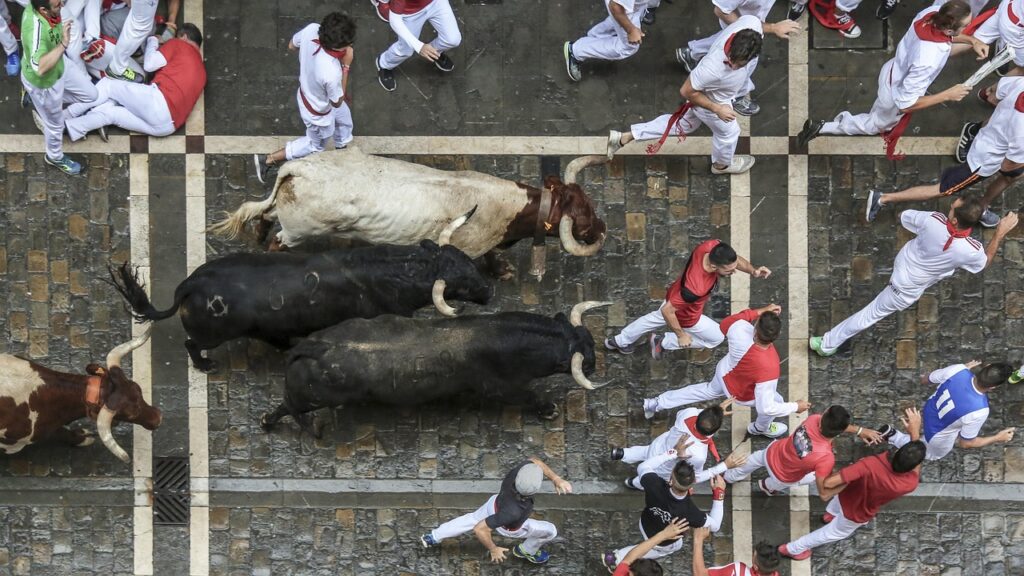The historic city of Pamplona is once again preparing for the world-renowned San Fermín Festival. Thousands of visitors and locals are expected as the festival officially kicks off on Sunday, July 6, 2025, at precisely 12:00 PM with the legendary rocket launch, the “Chupinazo,” from the balcony of the City Hall. Nine days full of adrenaline, tradition, and deeply rooted culture will culminate in the emotional closing ceremony on Monday, July 14, at midnight.
The Origins of a Myth: San Fermín and Its History
The roots of the San Fermín Festival stretch back centuries, combining the religious veneration of Saint Fermín, the first bishop and martyr of Pamplona, with ancient local and seasonal festivals. It is believed that San Fermín suffered martyrdom around 303 AD during Roman persecution. He became a revered patron saint of the region, and over time, the festival evolved into a fascinating blend of piety, revelry, and adrenaline-fueled spectacle that captivates people worldwide. The iconic white clothing symbolizes the purity and martyrdom of the Saint, while the red Pañuelo represents the blood of Saint Fermín, who died by decapitation. This color combination has become the visual identity of the festival, uniting thousands in honor of the Saint.
The Thrill of the “Encierro”: The Bull Run Up Close
The “Encierro” or bull run is undoubtedly the most famous and exhilarating event of the festival. Every morning from July 6 to July 14, hundreds, sometimes thousands, of runners, dressed in traditional white linen or cotton pants and shirts, with red scarves (Pañuelo) and red waist sashes (Faja), sprint alongside six powerful fighting bulls and typically three oxen. The 875-meter route begins at the Corral de Santo Domingo and ends at the Plaza de Toros (bullring). This dangerous and electrifying event originated from the practical need to herd livestock from the pastures to the bullring, where bullfights take place in the afternoon.
Runners require courage, agility, and a high degree of awareness, as the run lasts less than three minutes but has led to injuries and occasional fatalities in the past. The narrow, winding streets challenge even the most experienced participants. Safety personnel, medical teams, barriers, and protective fences line the route to quickly respond to accidents. The Ayuntamiento (City Council) continues to invest heavily in safety, including improved coordination of emergency measures, to make San Fermín 2025 as safe as possible.
The “Chupinazo”: A Festive Kick-off
The festival officially begins with the “Chupinazo,” a symbolic tradition dating back to the early 20th century. This loud, visual starting shot from the balcony of Pamplona’s City Hall at noon on July 6 marks the beginning of the festivities. Spectators, dressed in the characteristic white and red of the festival, enthusiastically shout “¡Viva San Fermín! ¡Gora San Fermín!” (“Long live San Fermín!” in Spanish and Basque), ushering in nine days of uninterrupted celebrations. For this year’s San Fermín 2025, the city council has installed six giant screens throughout the city to broadcast the event live, ensuring that everyone in the Plaza Consistorial and the surrounding streets can share in the excitement. Crowd control, sound systems, police, Guardia Civil, first-aid stations, and information points are set up to ensure a safe and smooth experience. Traffic services are also coordinated to efficiently manage the large influx of visitors.
San Fermín: A Global Phenomenon Beyond the Bull Run
San Fermín attracts approximately one million visitors from over 80 countries annually, making it a global cultural phenomenon. Beyond the bull run, the city comes alive with “gigantes y cabezudos” (giants and big-headed figures), traditional Basque music and dance performances, spectacular nightly fireworks, concerts, and more bullfights celebrating Spain’s rich heritage and vibrant traditions. The festival is a feast for all senses, offering a diverse program for all ages.
The Poignant “Pobre de mí” Ceremony
The festival concludes on July 14 at midnight with the “Pobre de mí” (“Poor me” or “Woe is me”) ceremony, held in the Plaza Consistorial. Thousands gather to sing a melancholic farewell song, expressing their sadness at the festival’s end. This shared lament symbolizes the unity, reflection, and emotional bonds formed during the festival’s duration, marking a poignant end to the lively celebrations.
San Fermín continues to be a symbol of courage, community spirit, and cultural identity, drawing the world’s attention to the heart of Pamplona every summer.




